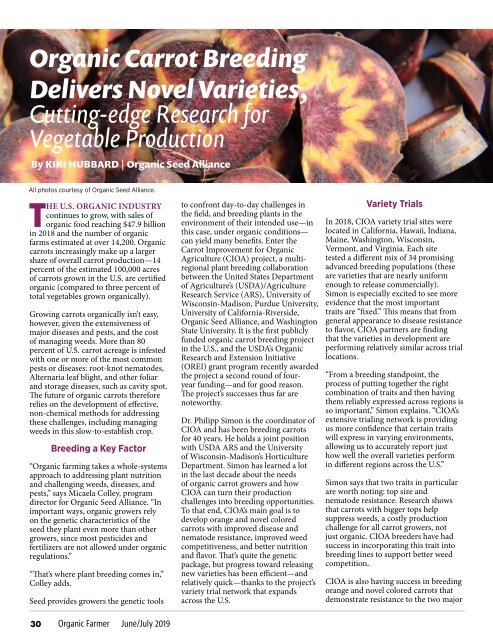Organic Farmer June 2019
You also want an ePaper? Increase the reach of your titles
YUMPU automatically turns print PDFs into web optimized ePapers that Google loves.
<strong>Organic</strong> Carrot Breeding<br />
Delivers Novel Varieties,<br />
Cutting-edge Research for<br />
Vegetable Production<br />
By KIKI HUBBARD | <strong>Organic</strong> Seed Alliance<br />
All photos courtesy of <strong>Organic</strong> Seed Alliance.<br />
THE U.S. ORGANIC INDUSTRY<br />
continues to grow, with sales of<br />
organic food reaching $47.9 billion<br />
in 2018 and the number of organic<br />
farms estimated at over 14,200. <strong>Organic</strong><br />
carrots increasingly make up a larger<br />
share of overall carrot production—14<br />
percent of the estimated 100,000 acres<br />
of carrots grown in the U.S. are certified<br />
organic (compared to three percent of<br />
total vegetables grown organically).<br />
Growing carrots organically isn’t easy,<br />
however, given the extensiveness of<br />
major diseases and pests, and the cost<br />
of managing weeds. More than 80<br />
percent of U.S. carrot acreage is infested<br />
with one or more of the most common<br />
pests or diseases: root-knot nematodes,<br />
Alternaria leaf blight, and other foliar<br />
and storage diseases, such as cavity spot.<br />
The future of organic carrots therefore<br />
relies on the development of effective,<br />
non-chemical methods for addressing<br />
these challenges, including managing<br />
weeds in this slow-to-establish crop.<br />
Breeding a Key Factor<br />
“<strong>Organic</strong> farming takes a whole-systems<br />
approach to addressing plant nutrition<br />
and challenging weeds, diseases, and<br />
pests,” says Micaela Colley, program<br />
director for <strong>Organic</strong> Seed Alliance. “In<br />
important ways, organic growers rely<br />
on the genetic characteristics of the<br />
seed they plant even more than other<br />
growers, since most pesticides and<br />
fertilizers are not allowed under organic<br />
regulations.”<br />
“That’s where plant breeding comes in,”<br />
Colley adds.<br />
Seed provides growers the genetic tools<br />
to confront day-to-day challenges in<br />
the field, and breeding plants in the<br />
environment of their intended use—in<br />
this case, under organic conditions—<br />
can yield many benefits. Enter the<br />
Carrot Improvement for <strong>Organic</strong><br />
Agriculture (CIOA) project, a multiregional<br />
plant breeding collaboration<br />
between the United States Department<br />
of Agriculture’s (USDA)/Agriculture<br />
Research Service (ARS), University of<br />
Wisconsin-Madison, Purdue University,<br />
University of California-Riverside,<br />
<strong>Organic</strong> Seed Alliance, and Washington<br />
State University. It is the first publicly<br />
funded organic carrot breeding project<br />
in the U.S., and the USDA’s <strong>Organic</strong><br />
Research and Extension Initiative<br />
(OREI) grant program recently awarded<br />
the project a second round of fouryear<br />
funding—and for good reason.<br />
The project’s successes thus far are<br />
noteworthy.<br />
Dr. Philipp Simon is the coordinator of<br />
CIOA and has been breeding carrots<br />
for 40 years. He holds a joint position<br />
with USDA ARS and the University<br />
of Wisconsin-Madison’s Horticulture<br />
Department. Simon has learned a lot<br />
in the last decade about the needs<br />
of organic carrot growers and how<br />
CIOA can turn their production<br />
challenges into breeding opportunities.<br />
To that end, CIOA’s main goal is to<br />
develop orange and novel colored<br />
carrots with improved disease and<br />
nematode resistance, improved weed<br />
competitiveness, and better nutrition<br />
and flavor. That’s quite the genetic<br />
package, but progress toward releasing<br />
new varieties has been efficient—and<br />
relatively quick—thanks to the project’s<br />
variety trial network that expands<br />
across the U.S.<br />
Variety Trials<br />
In 2018, CIOA variety trial sites were<br />
located in California, Hawaii, Indiana,<br />
Maine, Washington, Wisconsin,<br />
Vermont, and Virginia. Each site<br />
tested a different mix of 34 promising<br />
advanced breeding populations (these<br />
are varieties that are nearly uniform<br />
enough to release commercially).<br />
Simon is especially excited to see more<br />
evidence that the most important<br />
traits are “fixed.” This means that from<br />
general appearance to disease resistance<br />
to flavor, CIOA partners are finding<br />
that the varieties in development are<br />
performing relatively similar across trial<br />
locations.<br />
“From a breeding standpoint, the<br />
process of putting together the right<br />
combination of traits and then having<br />
them reliably expressed across regions is<br />
so important,” Simon explains. “CIOA’s<br />
extensive trialing network is providing<br />
us more confidence that certain traits<br />
will express in varying environments,<br />
allowing us to accurately report just<br />
how well the overall varieties perform<br />
in different regions across the U.S.”<br />
Simon says that two traits in particular<br />
are worth noting: top size and<br />
nematode resistance. Research shows<br />
that carrots with bigger tops help<br />
suppress weeds, a costly production<br />
challenge for all carrot growers, not<br />
just organic. CIOA breeders have had<br />
success in incorporating this trait into<br />
breeding lines to support better weed<br />
competition.<br />
CIOA is also having success in breeding<br />
orange and novel colored carrots that<br />
demonstrate resistance to the two major<br />
30<br />
<strong>Organic</strong> <strong>Farmer</strong> <strong>June</strong>/July <strong>2019</strong>


















